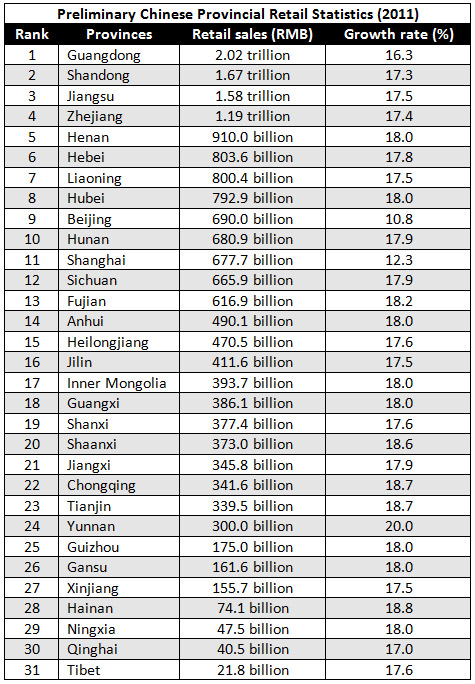China’s Provincial Retail Statistics for 2011
By Julia Gu
Also included: Figures on Chinese tourists’ retail spending abroad
Feb. 9 – According to preliminary data released from China’s National Bureau of Statistics, retail sales of consumer goods totaled RMB18.12 trillion (US$2.88 trillion) nationwide last year, up 17.1 percent year-on-year. While growth was 2.2 percentage points lower than the increase in 2010, China’s retail industry is expected to remain relatively strong in the near future amid declining export demand and a cooling real estate market – aided largely by the country’s expanding middle class population.
Zhu Haibin, chief economist with JP Morgan in China, has projected that retail sales in mainland China might maintain steady growth in 2012, despite the current negative factors that are adding pressure to the country’s economy. Furthermore, consumption may contribute about 4 percentage points of the increase in GDP.
In an attempt to expand the country’s economy, the Chinese government is trying to shift to a more consumption-led growth model, establishing more shopping centers across the country. During the 12th Five-Year Plan, Mainland China’s retail sales are expected to increase by 15 percent annually to reach RMB32 trillion (US$5.08 trillion).
Provincial retail statistics
When breaking down the provincial statistics, worth noting is Guangdong Province’s surpassing the RMB2 trillion mark and that only the coastal economies of Beijing, Shanghai and Guangdong recorded year-on-year growth rates of below 17 percent. The provincial breakdown is below, however, it should be noted that these are preliminary statistics and official statistics will come out later this year:

Chinese contributions to global retail sales
The Chinese middle class is forecasted to contribute more to global retail sales in the future, with their rising incomes and willingness to spend. During the recent Spring Festival holiday, luxury spending by Mainland Chinese tourists overseas rose nearly 30 percent this year to a record US$7.2 billion, while domestic spending totaled RMB470 billion (US$74.6 billion), up 16 percent from 2011.
In terms of global markets, Chinese shoppers are more attracted to Europe, where more than 46 percent of the US$7.2 billion in luxury goods consumption was distributed. Hong Kong, Macau and Taiwan together represented the second most popular destination outside Mainland China with a 35 percent share, while North America was third with 19 percent.
The World Luxury Association said that over the official holiday, Chinese tourists accounted for 62 percent of total sales in the European luxury goods market, 28 percent in the North American market and 69 percent in Hong Kong, Macao and Taiwan.
Mainland Chinese typically purchased watches, leather products, high-end clothes, cosmetics and perfumes in France, Italy, the United Kingdom and Switzerland, while domestic shoppers were mainly attracted to the first-tier cities of Shanghai and Beijing, where they typically bought luxury watches, jewelry, brand-name clothes, leather products, cosmetics, perfumes and wines.
This year, North America saw 7.5 percent growth in the luxury spending of Chinese tourists from last year. Mainland Chinese shoppers typically preferred popular tourist destinations including New York City, Los Angeles, Boston, Hawaii, Chicago and Washington.
Frost & Sullivan, an American consulting firm that provides customer-dependent market research and analysis, predicted that Chinese customers will spend a total of RMB570 billion on high-end products in domestic and overseas markets by 2015.
China is expected to be the top contributor to global growth in luxury sales and Chinese tourists are fueling demand in key global cities, said PricewaterhouseCoopers in its 2012 Outlook for the Retail and Consumer Products Sector in Asia.
Dezan Shira & Associates is a boutique professional services firm providing foreign direct investment business advisory, tax, accounting, payroll and due diligence services for multinational clients in China, Hong Kong, India, Singapore and Vietnam. For further information, please visit the firm’s web site or contact them at china@dezshira.com.
Related Reading
 Doing Business in China
Doing Business in China
Our 156-page definitive guide to the fastest growing economy in the world, providing a thorough and in-depth analysis of China, its history, key demographics and overviews of the major cities, provinces and autonomous regions highlighting business opportunities and infrastructure in place in each region. A comprehensive guide to investing in the country is also included with information on FDI trends, business establishment procedures, economic zone information, and labor and tax considerations.
 The Greater Pearl River Delta: Business Guide to South China (Fourth Edition)
The Greater Pearl River Delta: Business Guide to South China (Fourth Edition)
In this newly-released edition of our regional business guide to South China, we offer business-minded individuals an up-to-date reference source for all of the key issues concerning setting up and successfully operating a business in South China.
 The Yangtze River Delta: Business Guide to the Shanghai Region (Fourth Edition)
The Yangtze River Delta: Business Guide to the Shanghai Region (Fourth Edition)
This guide takes a practical, city-focused approach, walking you through the economy of important cities in the region with a level of specificity available through few other English sources. Its pages overview the region from a business standpoint, examine the economy of the region’s provinces and prominent cities in depth, and introduce the basics of establishing a business in the region.
New Complimentary China City Guides Available from Asia Briefing
India and China’s Retail Industries Compared
China’s Provincial GDP Figures in 2011
Top 50 Chinese Cities by Investment Potential
China’s Wine Market Shows Great Potential
- Previous Article Western Debt Crisis: A Turning Point for China?
- Next Article China Clarifies Favorable CIT Treatment to Infrastructure and “Green” Projects



























